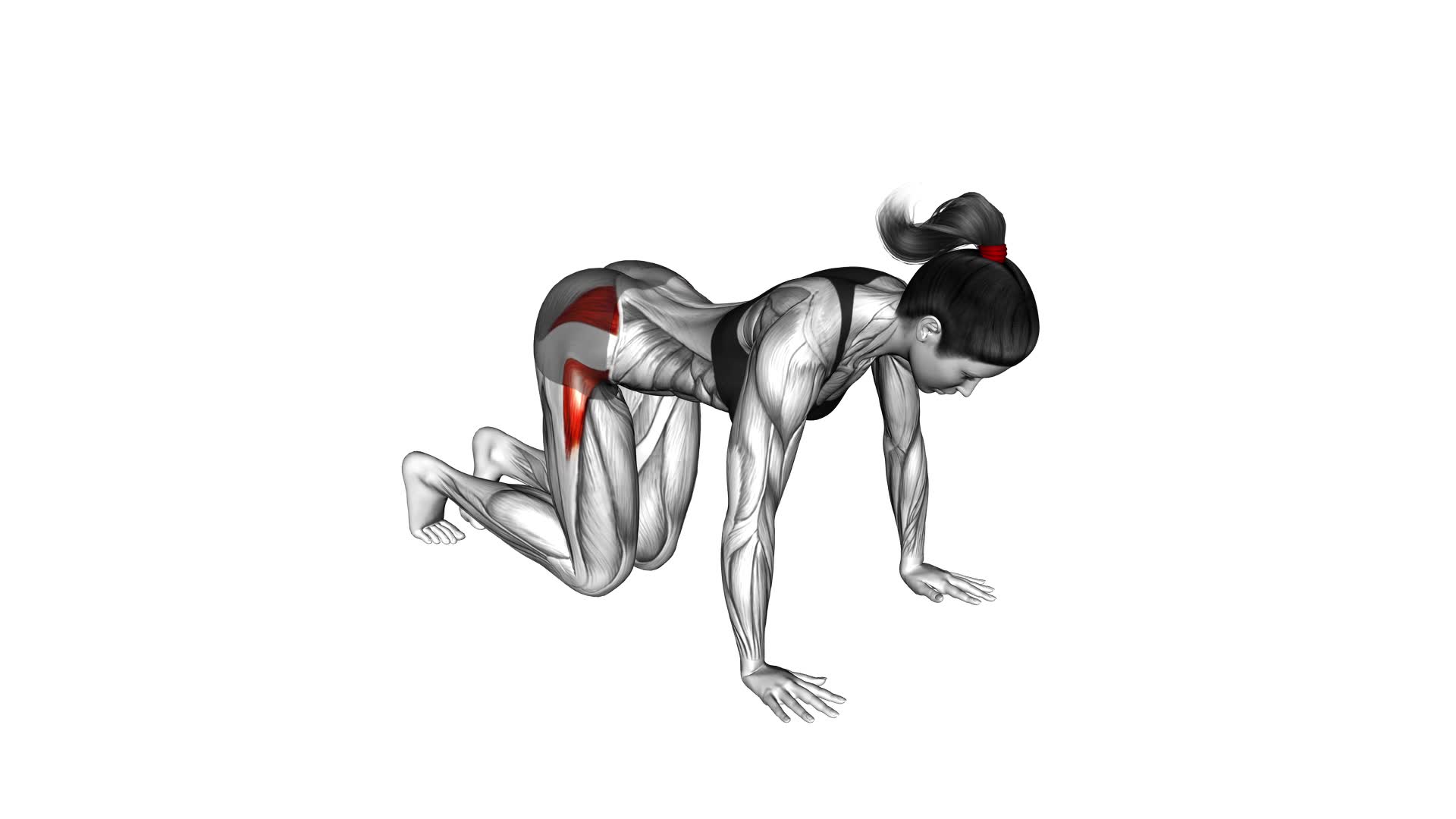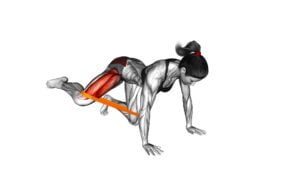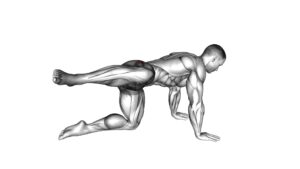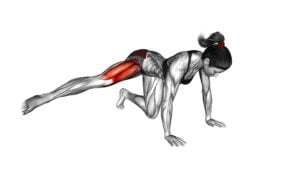Bent Leg Side Kick (kneeling) (female) – Video Exercise Guide & Tips

Get ready to kick up your fitness routine with the Bent Leg Side Kick!
Watch This Exercise Video
In this video exercise guide, we'll show you the proper form and technique for this challenging move. Whether you're a beginner or a seasoned athlete, our tips will help you maximize your workout and avoid common mistakes.
Grab your mat and get ready to strengthen your core and improve your balance with this powerful exercise.
Let's kick it into gear!
Key Takeaways
- The Bent Leg Side Kick targets multiple muscle groups including glutes, hamstrings, and quadriceps.
- It enhances lower body strength and stability, improves balance and coordination, and engages abdominal muscles to strengthen the core.
- Proper form and technique are important to maintain control, stability, and avoid common mistakes such as incorrect positioning and limited range of motion.
- Maintaining proper form is crucial for preventing potential knee injuries, maximizing workout effectiveness, and targeting specific muscle groups.
Benefits of the Bent Leg Side Kick
You will experience several benefits from incorporating the bent leg side kick into your exercise routine. This powerful kick targets multiple muscle groups, including your glutes, hamstrings, and quadriceps. By engaging these muscles, you can enhance your lower body strength and stability.
Additionally, the bent leg side kick helps to improve your balance and coordination, as it requires you to maintain control while executing the kick.
One of the key benefits of this exercise is its ability to target your core muscles. As you perform the bent leg side kick, you engage your abdominal muscles to stabilize your torso. This not only helps to strengthen your core, but also contributes to improved posture and spinal alignment.
To maximize the benefits of the bent leg side kick, it's important to focus on proper technique. Start by kneeling on your hands and knees, with your hands directly under your shoulders and your knees under your hips. From this position, lift one leg off the ground and extend it out to the side, keeping your knee bent. Make sure to maintain a neutral spine throughout the movement and avoid any excessive twisting or arching of the back.
Equipment Needed for the Exercise
To perform the Bent Leg Side Kick exercise, you'll need minimal equipment. Here are the three items you'll need:
- Exercise Mat: A comfortable and cushioned exercise mat is essential to provide support and prevent discomfort while performing the exercise. It also provides stability and prevents slipping during the movements.
- Resistance Band: Using a resistance band can add an extra challenge to the exercise, helping to strengthen and tone your muscles even more. Simply wrap the band around your thighs, just above your knees, to add resistance to the side kick movement.
- Chair or Wall: For beginners or individuals who may struggle with balance, using a chair or wall for support can be helpful. You can place your hand on the back of a chair or lean against a wall for stability while performing the exercise. This modification allows you to focus on the proper form and technique of the side kick without worrying about losing balance.
Remember to always choose a resistance band that matches your fitness level and start with a lighter resistance if you're a beginner. As you progress, you can gradually increase the resistance to continue challenging your muscles.
Proper Form and Technique
Maintaining proper form and technique is crucial for performing the Bent Leg Side Kick exercise effectively. To ensure you get the most out of this exercise, it's important to understand the correct form and technique.
One common misconception is that you need to kick as high as possible. However, the focus should be on maintaining control and stability throughout the movement. Start by kneeling on the ground with your hands resting on the floor in front of you. Place one leg in front of you, bent at a 90-degree angle, and extend the other leg out to the side.
As you kick your extended leg out to the side, keep your core engaged and maintain a straight line from your head to your extended foot. Avoid leaning back or hunching forward during the movement. The goal is to engage your glutes and outer thigh muscles, so focus on squeezing them as you bring your leg back to the starting position.
Once you have mastered the basic form, you can try advanced variations of the Bent Leg Side Kick. This may include adding ankle weights or using a resistance band for added resistance. Remember to always listen to your body and only progress to advanced variations when you feel comfortable and confident in your form and technique.
Common Mistakes to Avoid
To ensure proper technique, beginners should focus on correcting common mistakes when performing the bent leg side kick.
This includes maintaining a straight back, engaging the core muscles, and keeping the knee aligned with the foot to prevent potential knee injuries.
Technique Corrections for Beginners
Avoid these common mistakes to improve your technique when performing the Bent Leg Side Kick (kneeling) exercise as a beginner:
- Incorrect positioning: One common mistake isn't placing your supporting hand directly under your shoulder, or not aligning your knee with your hip. To correct this, ensure that your hand is directly beneath your shoulder and your knee is aligned with your hip. This will provide stability and prevent strain on your joints.
- Lack of control and balance: Beginners often struggle with maintaining control and balance during the bent leg side kick. To address this, focus on engaging your core muscles and keeping your body centered. This will help you stay balanced and execute the kick with control.
- Limited range of motion: Some beginners may have difficulty achieving a full range of motion with their kick. Start by practicing the kick with smaller movements, gradually increasing the range as you gain strength and flexibility. Additionally, incorporating stretching exercises for the hip flexors and hamstrings can help improve your range of motion over time.
Preventing Potential Knee Injuries
To prevent potential knee injuries, focus on maintaining proper form and alignment throughout the Bent Leg Side Kick (kneeling) exercise. It's crucial to prioritize stretching and strengthening exercises to ensure the stability and flexibility of your knee joints.
Before starting the exercise, warm up your muscles and perform dynamic stretches to prepare your body for the movement. This will help increase blood flow and flexibility, reducing the risk of injury.
Additionally, incorporating strengthening exercises that target the muscles surrounding the knee, such as the quadriceps and hamstrings, will provide support and stability during the exercise.
Remember to execute the side kick with controlled movements and avoid excessive force or jerking motions, as this can strain the knees.
Modifications for Beginners
If you're new to the bent leg side kick exercise, a modification that can help you build strength and stability is to perform the movement while kneeling on a mat or soft surface. Here are three modifications for beginners to consider:
- Start with a shorter range of motion: Instead of trying to kick your leg high, focus on the movement and control of your leg. Begin by lifting your leg just a few inches off the ground and gradually increase the height as you build strength.
- Use a support: If you're finding it challenging to balance during the exercise, use a chair or wall for support. Place your hand on the support to help stabilize yourself while performing the bent leg side kick.
- Decrease the number of repetitions: As a beginner, it's important to listen to your body and not push yourself too hard. Start with a lower number of repetitions, such as 5 on each side, and gradually increase as you become more comfortable and confident with the exercise.
Remember to focus on proper form and technique throughout the exercise. Engage your core, keep your back straight, and breathe deeply. With consistency and practice, you'll gradually build strength and be able to perform the bent leg side kick exercise with ease.
Tips for Maximizing Your Workout
To maximize your workout, it's important to focus on proper form and technique. By maintaining correct form, you can ensure that you're targeting the specific muscle groups intended for each exercise.
This will help you get the most out of your workout and avoid potential injuries.
Proper Form Importance
Achieving proper form during your workout is crucial for maximizing results. Here are three important reasons why proper alignment is essential and common misconceptions to be aware of:
- Importance of alignment: Proper form ensures that your body is in the correct position to effectively work the targeted muscles. It helps prevent injuries, as well as promotes optimal muscle activation and engagement. Aligning your body correctly allows you to achieve the desired results from your workout.
- Common misconceptions: One common misconception is that sacrificing form for more weight or speed leads to better results. However, this can increase the risk of injury and diminish the effectiveness of the exercise. Another misconception is that form doesn't matter as long as you're feeling the burn. In reality, poor form can lead to muscle imbalances and hinder progress.
- Maximizing your workout: By prioritizing proper form, you can ensure that you're getting the most out of each exercise. It allows you to target the intended muscles, increase the intensity of the workout, and maintain control throughout the movement. Remember, quality over quantity is key when it comes to maximizing your workout.
Targeting Specific Muscle Groups
Focus on targeting specific muscle groups to maximize your workout and achieve optimal results. By focusing on specific muscles, you can prevent muscle imbalances and increase flexibility.
It's important to understand which muscles you want to target and how to effectively engage them during your workout. For example, if you want to target your glutes and hamstrings, exercises like bent leg side kicks (kneeling) can be highly effective.
To perform this exercise, start by kneeling on the ground with one knee bent at a 90-degree angle. Extend your other leg out to the side, keeping it straight. Then, lift your leg up as high as you can while maintaining control.
This exercise specifically targets the glutes and hamstrings, helping to prevent muscle imbalances and increase flexibility in these areas.
Remember to always listen to your body and modify exercises as needed to fit your fitness level and goals.
Frequently Asked Questions
How Many Calories Can You Burn by Doing the Bent Leg Side Kick Exercise?
You can burn a significant amount of calories by doing the bent leg side kick exercise.
This exercise engages multiple muscle groups, including the glutes, thighs, and core.
The more muscles you activate during a workout, the more calories you burn.
The bent leg side kick specifically targets these areas, making it an effective exercise for calorie burning and muscle toning.
Incorporate this exercise into your routine for a challenging and rewarding workout.
Can the Bent Leg Side Kick Exercise Help With Toning the Glutes?
Yes, the bent leg side kick exercise can help with toning your glutes. By performing this exercise, you engage the muscles in your glutes, which helps to strengthen and tone them over time.
Additionally, the bent leg side kick exercise has other benefits, such as improving hip stability and increasing core strength.
There are also variations of this exercise that you can try to target different areas of your glutes and add variety to your workout routine.
Is the Bent Leg Side Kick Exercise Suitable for Individuals With Knee Injuries?
If you have knee injuries, the bent leg side kick exercise may not be suitable for you. It puts strain on your knees and can worsen your condition.
Instead, there are alternative exercises you can do to target your glutes without putting pressure on your knees. Try exercises like glute bridges, clamshells, or donkey kicks.
These modifications will help you tone your glutes while protecting your knees from further harm.
How Often Should the Bent Leg Side Kick Exercise Be Performed for Optimal Results?
To get optimal results from the bent leg side kick exercise, it's important to consider the workout frequency.
You should aim to perform this exercise at least 2-3 times per week. This will allow your muscles to recover while still challenging them enough to see progress.
Additionally, don't be afraid to explore different exercise variations to keep things interesting and target different muscle groups.
Remember to always listen to your body and adjust the frequency according to your fitness level and goals.
Are There Any Specific Warm-Up Exercises Recommended Before Attempting the Bent Leg Side Kick Exercise?
Before attempting the Bent Leg Side Kick exercise, it's important to warm up properly. Incorporating dynamic stretches and mobility exercises into your warm-up routine can help prepare your muscles and joints for the movement.
These types of exercises help increase blood flow, improve flexibility, and reduce the risk of injury. So, make sure to include some dynamic stretches and mobility exercises in your warm-up before attempting the Bent Leg Side Kick.
Conclusion
In conclusion, the bent leg side kick is a highly effective exercise that targets the lower body and improves flexibility, strength, and balance.
By following the proper form and technique, avoiding common mistakes, and making modifications for beginners, you can maximize the benefits of this exercise.
Remember to always listen to your body and consult with a professional trainer if needed.
Incorporate this exercise into your routine for a challenging and rewarding workout.

Author
Years ago, the spark of my life’s passion ignited in my mind the moment I stepped into the local gym for the first time. The inaugural bead of perspiration, the initial endeavor, the very first surge of endorphins, and a sense of pride that washed over me post-workout marked the beginning of my deep-seated interest in strength sports, fitness, and sports nutrition. This very curiosity blossomed rapidly into a profound fascination, propelling me to earn a Master’s degree in Physical Education from the Academy of Physical Education in Krakow, followed by a Sports Manager diploma from the Jagiellonian University. My journey of growth led me to gain more specialized qualifications, such as being a certified personal trainer with a focus on sports dietetics, a lifeguard, and an instructor for wellness and corrective gymnastics. Theoretical knowledge paired seamlessly with practical experience, reinforcing my belief that the transformation of individuals under my guidance was also a reflection of my personal growth. This belief holds true even today. Each day, I strive to push the boundaries and explore new realms. These realms gently elevate me to greater heights. The unique combination of passion for my field and the continuous quest for growth fuels my drive to break new ground.







